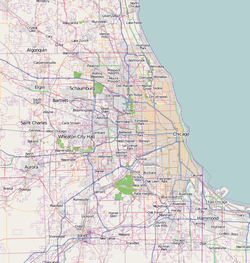Boyce Building
|
Boyce Building
|
|
 |
|
| Location | 500--510 N. Dearborn St., Chicago, Illinois |
|---|---|
| Coordinates | 41°53′28″N 87°37′48″W / 41.89111°N 87.63000°WCoordinates: 41°53′28″N 87°37′48″W / 41.89111°N 87.63000°W |
| Area | 0.3 acres (0.12 ha) |
| Built | 1915 |
| Architect | Daniel H. Burnham & Co., Christian A. Eckstrom |
| Architectural style | Classical Revival, Chicago, Commercial Style |
| NRHP Reference # | 96000080 |
| Added to NRHP | February 29, 1996 |
The Boyce Building is an historic building in Chicago, Illinois, associated with William D. Boyce and his publishing house, which catered to small towns. The building was also the headquarters of his Lone Scouts of America.
The Boyce Building is a twelve-story office building clad in light gray Vermont granite and red brick. The steel-framed structure is on the northwest corner of Dearborn and Illinois Streets on Chicago's Near North Side. It was built in three phases from 1911 to 1923. Boyce commissioned Daniel H. Burnham & Co. to design the building in 1911. Plans were made to expand it to a ten-story structure, but this never happened. A four-story section of the building was built in 1912 north of another building housing Boyce's offices. The older building was then demolished, and the second portion of the four-story building was completed in 1914. The basement had a power plant and the first floor housed five printing presses and a mail room. The building could manufacture 180,000 papers per hour at full capacity.
Christian A. Eckstrom designed an eight-story expansion in 1921, completed in 1923. Eckstrom adopted some of Burnham's plan, but eliminated his mansard roof, making a more cohesive though less intricate building. A terra cotta cornice was removed in the 1980s.
William D. Boyce was born in Pennsylvania and grew up in a rural town. He moved to Chicago in 1881, where he gained experience in sales and publishing. He briefly moved to Winnipeg, Manitoba, where he co-founded The Commercial, then found a job as a reporter in Fargo, North Dakota. In 1882, he moved to nearby Lisbon, North Dakota, and founded the Dakota Clipper weekly newspaper. During the 1884 World Cotton Centennial, Boyce worked at the Bureau of Correspondence, which provided news from the fair to 1200 member newspapers across the nation. He sold his interest in the Clipper in 1885 and returned to Chicago with an interest in small-town news.
Boyce partnered with R. R. Donnelley to found a print service for small-town newspapers. These "ready print" stories catered to the interest of small-town readers, but were of higher quality than most towns could otherwise afford. He convinced Donnelley and two other partners to found a national weekly newspaper to cater to these audiences, the Saturday Blade. First published in June 1887, Boyce soon purchased the shares of his partners and managed the paper as the W. D. Boyce Publishing Company. Boyce purchased a story paper, the Chicago Ledger, in 1891. He consolidated his publishing interests into one building 1907. Boyce distributed his papers through a network of paperboys. At its peak in the 1910s, his agency was associated with 30,000 boys throughout the United States and Canada.
...
Wikipedia



